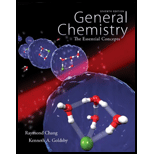
Interpretation:
Spontaneous process has to be explained and two examples for spontaneous and non spontaneous process have to be given.
Concept introduction:
Any natural process or a
Answer to Problem 18.1QP
Spontaneous process can be defined as any process that is occurring without the influence of external energy or influence. Melting of ice in room temperature and rusting of iron at room temperature are examples of spontaneous processes. Spontaneous process is associated with a decrease in free energy and the increase in the entropy of the system.
Non spontaneous process is initiated with the help of an external energy. Flow of heat from low temperature region to high temperature region and diffusion of gas molecules, from region of high pressure to low pressure are the examples of nonspontaneous process. There will be an increase in free energy and decrease of entropy of the system.
Explanation of Solution
To define spontaneous process
Spontaneous process can be defined as any process that is occurring without the influence of external energy.
Spontaneous process is any process which can take place by itself. Spontaneous process is associated with a decrease in free energy and the increase in the entropy of the system. Ice is melted into water at room temperature without the influence of any external energy. Hence it is an example of spontaneous process.
To give examples for spontaneous process
Any process that is initiated by itself is spontaneous.
Examples for spontaneous process
- Melting of ice in room temperature
- Rusting of iron at room temperature
To explain non-spontaneous process
Non spontaneous process is initiated with the help of an external energy.
Non spontaneous process is initiated with the help of an external energy. For example, the flow of heat from low temperature region to high temperature region is not possible without the external influence. It can be considered as a nonspontaneous process. There will be an increase in free energy and decrease of entropy of the system.
To give examples for nonspontaneous process
A process which is initiated by external influence of energy is nonspontaneous.
Examples of non spontaneous process
- Flow of heat from low temperature region to high temperature region.
- Diffusion of gas molecules from region of high pressure to low pressure
Spontaneous process was explained and two examples for spontaneous and non-spontaneous processes were given.
Want to see more full solutions like this?
Chapter 18 Solutions
Connect 2-Year Access Card for Chemistry: The Essential Concepts
 ChemistryChemistryISBN:9781305957404Author:Steven S. Zumdahl, Susan A. Zumdahl, Donald J. DeCostePublisher:Cengage Learning
ChemistryChemistryISBN:9781305957404Author:Steven S. Zumdahl, Susan A. Zumdahl, Donald J. DeCostePublisher:Cengage Learning ChemistryChemistryISBN:9781259911156Author:Raymond Chang Dr., Jason Overby ProfessorPublisher:McGraw-Hill Education
ChemistryChemistryISBN:9781259911156Author:Raymond Chang Dr., Jason Overby ProfessorPublisher:McGraw-Hill Education Principles of Instrumental AnalysisChemistryISBN:9781305577213Author:Douglas A. Skoog, F. James Holler, Stanley R. CrouchPublisher:Cengage Learning
Principles of Instrumental AnalysisChemistryISBN:9781305577213Author:Douglas A. Skoog, F. James Holler, Stanley R. CrouchPublisher:Cengage Learning Organic ChemistryChemistryISBN:9780078021558Author:Janice Gorzynski Smith Dr.Publisher:McGraw-Hill Education
Organic ChemistryChemistryISBN:9780078021558Author:Janice Gorzynski Smith Dr.Publisher:McGraw-Hill Education Chemistry: Principles and ReactionsChemistryISBN:9781305079373Author:William L. Masterton, Cecile N. HurleyPublisher:Cengage Learning
Chemistry: Principles and ReactionsChemistryISBN:9781305079373Author:William L. Masterton, Cecile N. HurleyPublisher:Cengage Learning Elementary Principles of Chemical Processes, Bind...ChemistryISBN:9781118431221Author:Richard M. Felder, Ronald W. Rousseau, Lisa G. BullardPublisher:WILEY
Elementary Principles of Chemical Processes, Bind...ChemistryISBN:9781118431221Author:Richard M. Felder, Ronald W. Rousseau, Lisa G. BullardPublisher:WILEY





